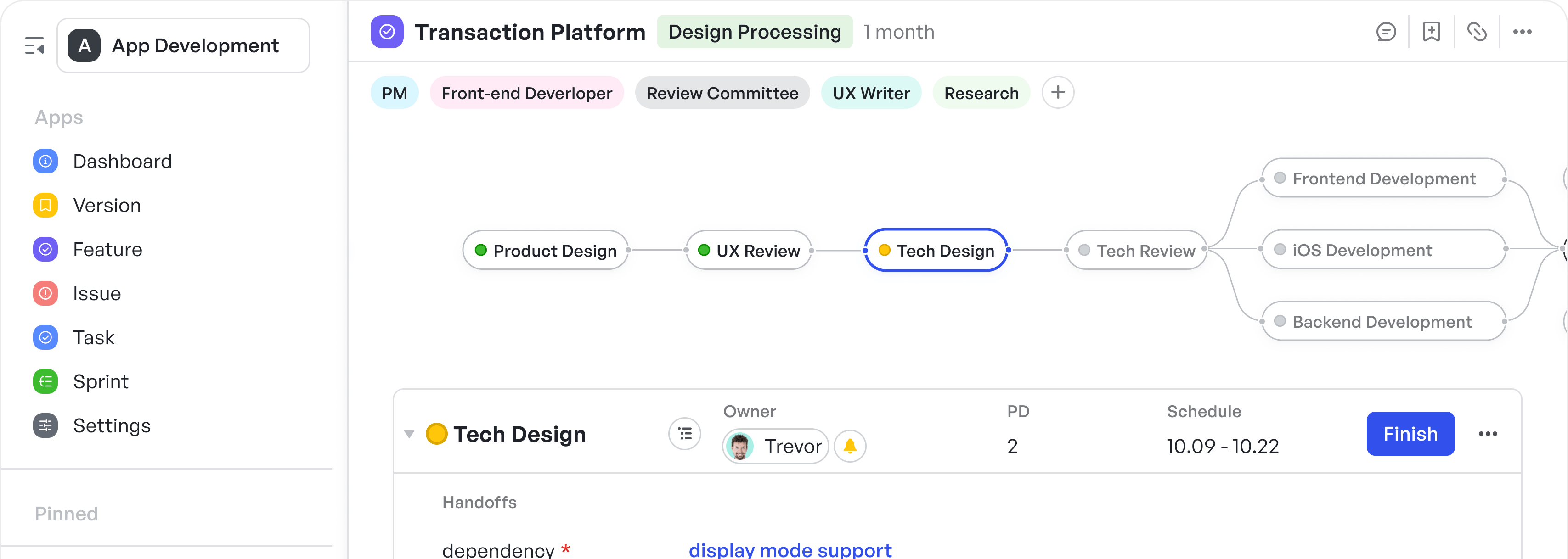Product managers have one of the most complicated jobs in the corporate world. From coordinating and communicating to interviewing customers and removing roadblocks, their work is full of challenges. The top 3 include:
- Prioritization (63%)
- Getting buy-in from stakeholders (55%)
- Balancing customer needs with business objectives (46%)
Developing a product roadmap lays the groundwork for resolving these issues. You’ll have a clear view of where each initiative starts and ends, who is accountable for specific tasks, and the expected release date for each feature.
However, just building a roadmap is not enough. The real struggle begins in designing a roadmap that aligns everyone with the product vision, offering enough detail for each department without losing sight of the high-level objectives.
In this blog post, we'll dive into some outstanding project roadmap examples and learn how to create a product roadmap that delivers results. These insights will help bring focus, alignment, and productivity to your development journey.
250px|700px|reset
加载中,请稍后
What is a Product Roadmap?
A product roadmap is a visual guide that outlines all key elements and initiatives involved in the product development journey. It offers a strategic overview of timelines, teams, departments, objectives, and activities essential for successful product creation. The product manager leads and oversees each stage of the roadmap.
A product roadmap acts as both a reference and guide, steering the product team’s actions across various situations. It combines feature requests, internal insights, timelines, customer feedback, and other critical elements, typically created after the product strategy is established.
A product roadmap is:
- A straightforward, clear communication tool that’s easy to understand.
- A high-level snapshot of prioritized themes or initiatives based on strategies to achieve business goals.
- Flexible, adaptive, and continually evolving.
Essential Elements of a Product Roadmap
Your product roadmap should clearly express your product strategy, making it accessible and understandable to all audiences, each with their own needs and perspectives. Here is what you should include:
- Timeline
- Timeline
The timeline is the most important element of your Roadmap. It typically shows when new products and updates to existing ones will be released. Depending on the required detail level, you may break down timelines into days, weeks, or months—and, in some cases, even plan years in advance.
- Features
- Features
Features provide detailed information about new or improved functionality that delivers value to users. You can categorize them based on the messages you want to convey and the project management tools you use. They can be presented as individual features you’re developing, or you can create a hierarchy that starts with broad feature themes and narrows down to specific subfeatures.
- Goals
- Goals
Goals are specific metrics you hope to achieve with your products and features within a particular period. All goals must be:
- Measurable
- Achievable
- Actionable
- Easy to understand
- User persona
- User persona
User personas are fictional representations of users who will interact with your product. They center around these users' key characteristics, behaviors and goals, which can help guide product decisions. Each persona should have a name, a picture and a job title—for example, Ron, the startup founder or Ema, the everyday user.
Why is it Important to Tailor your Roadmap to the Right Audience?
Different stakeholders care about different things. Executives want to see the bigger picture and understand how the product aligns with business goals while developers just need the specifics to know what to build next.
That is why it is important to tailor your roadmap to cater to everybody’s unique needs and demands. Additionally, a tailored roadmap can help in:
- Aligning stakeholders
- Aligning stakeholders
The roadmap is transparent and visible to all stakeholders so they can comment, discuss, and give feedback. This is to ensure the activities of different stakeholders align and coordinate with each other. With an established roadmap, no team can stray away from their commitments and are accountable to each other.
- Improving cross-functional collaboration
- Improving cross-functional collaboration
Company roadmaps, such as release plans or release timeline roadmaps, help share detailed information, such as sales and customer success, with cross-functional teams. These roadmaps enable teams to set relevant expectations with prospects and customers, considering comments and customer feedback.
- Guiding decision-making and creativity
- Guiding decision-making and creativity
Since roadmaps are comprehensive and detailed, they are often an excellent tool for inspiration and guiding decision-making. If any product manager ever finds themselves short on ideas, they can revisit the roadmap for fresh, new perspectives.
- Supporting customer-centric development
- Supporting customer-centric development
Customer-focused roadmaps, such as the now-next-later roadmap or a release plan, enable customization according to customer needs. They are also useful in communicating upcoming tasks to internal customer-facing audiences,such as sales, customer success, and marketing.
7 Examples of Effective Roadmaps
An organization can use multiple roadmaps—-for specific users or departments. The best product roadmap for you or your department depends on several factors such as your company’s goals, audience, and the level of detail needed. Here is a look on 7 of the most commonly used roadmaps to help you figure out which one will suit you the best:
- Release plan
- Release plan
Release plans focus on capturing and executing a product’s development timeline, features, enhancements and bug fixes planned for an upcoming release. They communicate a high-level overview of all the initiatives and are accessible to senior executives, stakeholders, cross-functional teams, and even customers.
250px|700px|reset
加载中,请稍后
The release plan serves as a management tool to track progress while ensuring all milestones are met. It typically includes:
- Date of upcoming releases
- Detailed plans outlining all features, bug fixes, and other improvements
- Subsequent iterations after the initial release
- Feature development so team member knows what to prioritize and when it needs to be completed
- Features each release will contain so stakeholders know when they can expect a particular feature
- Sprint plan roadmap
- Sprint plan roadmap
As the name suggests, a sprint plan roadmap breaks down the overall product development timeline into shorter, manageable periods called sprints. The sprints usually last 1-4 weeks and focus on delivering specific features or improvements in each sprint.
250px|700px|reset
加载中,请稍后
Agile development teams mostly use this roadmap to ensure continuous improvement, feedback and alignment with changing product needs. It includes the following elements:
- Time-bound goals with a defined duration
- Actionable tasks detailing the specific functions, features, or bug fixes that will be worked on during the sprint
- Priorities based on product goals and user feedback
- Iteration and review to help teams improve their processes
- Flexibility allows for adjustments based on new information and priorities
- Kanban roadmap
- Kanban roadmap
A Kanban roadmap uses the Kanban board style, featuring columns and cards. “Kanban” is a Japanese word for “visual board" or “sign.” It focuses on continuous work delivery by visualizing tasks as they move through different stages of development.
250px|700px|reset
加载中,请稍后
Kanban boards move from left to right as you keep completing tasks (e.g “To Do”, “Doing”, “Done”). Kanban stands out in the sense that it focuses more on managing the flow of work rather than strict timelines. Some of its key features include:
- Tasks are represented as cards or items on a board
- Continuous delivery with tasks being released as soon as they are ready
- No strict deadlines allow for more adaptability and room for changes in product requirements or team capacity.
- Now-next-later roadmap
- Now-next-later roadmap
The now-next-later roadmap organizes work into three segments, from immediate to long-term. It starts with the most urgent problems to solve and gradually moves towards the less important ones. This roadmap is lean by nature and works excellently with teams that work the lean way.
250px|700px|reset
加载中,请稍后
Each of the now, next, and later columns contains product initiatives or ideas but varies in certainty and scope.
Now: Current initiatives that you are working on. The items are clearly defined and much more detailed than the other two columns.
Next: Everything that will happen once the now column is complete. The items are broken down into fewer specifics and details.
Later: Everything else you want to do but won’t happen until some time. The items are unclear and include general problems you want to solve but don’t have the exact details.
- Features timeline roadmap
- Features timeline roadmap
A features timeline roadmap displays a detailed view of the specific functionality or improvements that the team is building, along with a timeline. It communicates the flow and progress of the development of product features and when they’ll be completed.
250px|700px|reset
加载中,请稍后
Product managers use this roadmap to share work details with the cross-functional product team, the broader organization, and sometimes even customers. They are often presented in the form of:
- Goal-based roadmaps: displaying the specific business and product goals
- Theme-based roadmaps: displaying the themes you are working on
- Outcome-driven roadmaps: built around customers and business values
- Objectives timeline roadmap
- Objectives timeline roadmap
An objective timeline roadmap provides a broad organizational alignment with product direction. They are great to share your product strategy and goals with your stakeholders for the next 2-3 quarters.
250px|700px|reset
加载中,请稍后
Rather than simply detailing the features or tasks to be completed, this roadmap outlines the key business or product goals and the timeline for reaching them. It focuses on:
- Aligning day-to-day activities with long-term goals
- Breaking down time intervals by quarters or months
- Including milestones that track progress toward each objective
- Prioritizing objectives based on strategic importance
- Portfolio roadmap
- Portfolio roadmap
A portfolio roadmap provides a comprehensive overview of an organization's entire product portfolio. It allows executives and product managers to see how different products relate to each other and how individual products evolve over time.
250px|700px|reset
加载中,请稍后
This roadmap enables the visualization of multiple product plans on a single roadmap representing key milestones for all initiatives, products or projects. Key features include:
- Cross-team collaboration allows stakeholders from different teams to coordinate their efforts
- Resource management by prioritizing and allocating resources across the portfolio
- Milestones and deliverables for each initiative within the portfolio
How to Implement and Maintain Roadmaps?
A resilient roadmap depends on its structure to identify roadblocks and navigate the product development lifecycle smoothly. The way you arrange and organize different components of the roadmap reflects your product strategy, so you want to do it in the most calculated way. Here is a step-by-step process of how you can implement and maintain roadmaps:
- Define your strategy
- Define your strategy
Your vision will help you define your strategies. Once your plan is ready, you can build your activities around it to complement your goals and vision.
For example, you are building a contact center tool and your vision is to become one of the industry’s best. Your goals are to achieve a defined annual revenue mark, expand your reach in different geographical markets, and create a solid brand image.
Accordingly, your strategy may include :
- Defining actionable steps to reach the revenue target, such as offering tiered service levels or introducing value-added features that justify premium pricing
- Localizing the product to meet regional regulatory requirements, such as setting up region-specific customer support teams
- Content marketing with blogs and video materials, developing case studies etc
- Collect inputs and feedback from stakeholders
- Collect inputs and feedback from stakeholders
Now that your strategy is set, you should collect feedback from stakeholders and even customers to determine whether everyone is on the same page. Encourage stakeholders to share their pain points and expectations regarding the product.
For example, the sales team can provide insights on the most sought-after features, the support team can highlight common customer complaints, and the development team can flag technical limitations or opportunities.
- Prioritize the collected feedback and feature requests
- Prioritize the collected feedback and feature requests
Not all feedback and requests are of equal importance. As a product manager, you should know how to prioritize feedback based on its urgency and importance. To rank feedback systematically, you can apply a prioritization framework such as :
- RICE (Reach, Impact, Confidence, Effort)
- Kano Model
- MoSCoW (must-have, should-have, could-have, won’t-have)
- Value Vs. Effort
- Set a time frame and allocate resources
- Set a time frame and allocate resources
Setting a timeline keeps all departments alert about their duties and responsibilities. With a well-built product roadmap, you can effectively allocate resources and responsibilities to stakeholders while keeping track of their activities within a defined period.
Allocating resources and initiatives help different departments of your company to develop the product features. Budgets have to be given out for each task on the map such as design, marketing , and research.
- Pick the most-suitable roadmap templates
- Pick the most-suitable roadmap templates
Finally it’s time to take action and pick a product roadmap template that suits your strategy the best. A well-defined roadmap clearly defines the tasks and responsibilities of stakeholders against a timeline.
Ensure to pick a roadmap template that can be formatted accordingly to suit all stakeholders' needs and requirements. For example, a release plan template is best for delivering information to existing customers and prospects, a sprint plan roadmap is suitable for agile development environments, and the most ideal one for an investor is an objectives timeline roadmap.
- Update your roadmap continuously
- Update your roadmap continuously
A product roadmap should be dynamic to incorporate changing market trends, inputs, and feedback daily. The product manager is responsible for continuously reviewing and updating the roadmap to accommodate the volatility of the market and its demands.
Using Meegle to Simplify Product Roadmap Management
Meegle is a complete project management suite that allows product managers to explore the different facets of product management. It offers a user-friendly and intuitive interface and offers multiple built-in templates to drive productivity while ensuring effortless coordination between teams.
Let’s understand how it can make your product management process more efficient and seamless:
- Setting clear goals and objectives
- Setting clear goals and objectives
The roadmap's first and most crucial step is formulating strategies based on your goals. The goals and objectives that you set must be clearly defined and communicated to all stakeholders so they work together towards achieving them.
250px|700px|reset
加载中,请稍后
Outline milestones and set clear goals for the project
- Monitoring time and progress
- Monitoring time and progress
Managing your time is critical when building roadmaps, as it can directly impact your planning and execution. Meegle’s Gantt view chart can help you priortize key objectives, define and meet deadlines, and allocate resources effectively.
250px|700px|reset
加载中,请稍后
Get a bird’s eye view of how each of your tasks progresses
Meegle clearly depicts task durations and deadlines within each sprint. You can also add custom work items as per your need and highlight dependencies between tasks to ensure that every stakeholder understands the project objectives and timelines.
- Live collaboration across teams
- Live collaboration across teams
Roadmaps are not just blueprints but also powerful communication tools that can generate discussions about various aspects of the product. Meegle’s real-time collaboration tools unite managers, developers, designers, and other stakeholders.
250px|700px|reset
加载中,请稍后
Assign specific roles and responsibilities to engage each team member effectively
The platform is open for team members to leave comments, update tasks, and provide instant feedback, ensuring no miscommunication or delays in decision-making.
- Setting priorities for features and tasks
- Setting priorities for features and tasks
Prioritization tools are essential to determine the urgency and importance of each feature and task. Meegle offers prioritization tools with built-in criteria like impact, effort, and urgency, which allow teams to rank initiatives and features. This is to ensure the most critical tasks are completed first.
250px|700px|reset
加载中,请稍后
Get a clear view of priorities at a glance and modify them as required
Meegle helps you compare different initiatives to identify what will drive the most value for your product and customers. You can use Meegle’s Agile Development template for a more systematic view of the product roadmap with epics, stories, versions and sprints.
250px|700px|reset
加载中,请稍后
Organize product roadmap with epics, stories, versions & sprints
- Regular feedback and iterative enhancements
- Regular feedback and iterative enhancements
As previously mentioned, a product roadmap is dynamic. It evolves continuously to adapt to customer feedback and market conditions. Meegle connects feedback loops directly into the roadmap so teams can iterate based on real-time data. It keeps the product up-to-date and in tune with user expectations.
- Keeping all stakeholders coordinated
- Keeping all stakeholders coordinated
Product managers face the biggest challenge in coordinating stakeholders. Meegle steps in to solve this problem by ensuring the roadmap is always up-to-date and easily accessible.
250px|700px|reset
加载中,请稍后
Keep stakeholders updated on the status and background details
Stakeholders, both internal and external, can monitor the roadmap to spot vital milestones and understand where the project is headed. The roadmap serves as the single source of truth for all stakeholders, and its transparency reduces the need for constant status updates.
- Quick adaptations for ongoing agility
- Quick adaptations for ongoing agility
Meegle is designed to adapt to changing demands and requirements without compromising goals. Whenever a new opportunity arises or customer demands shift, product managers can make quick adjustments to the roadmap, restructure priorities or modify timelines accordingly.
Additionally, Meegle offers:
- Flexible configuration
- Complete visibility
- No-code automation
- Integration with existing product management practices
Create Your Roadmap with Meegle
By now, you must have a fair idea of the different types of roadmaps and how to create one. Remember that each product roadmap style serves a unique purpose and caters to different audiences.
If you are not too sure about which roadmap to utilize, you can try experimenting with different roadmap styles with Meegle. It offers a suite of templates to help you get started on your product development journey.





